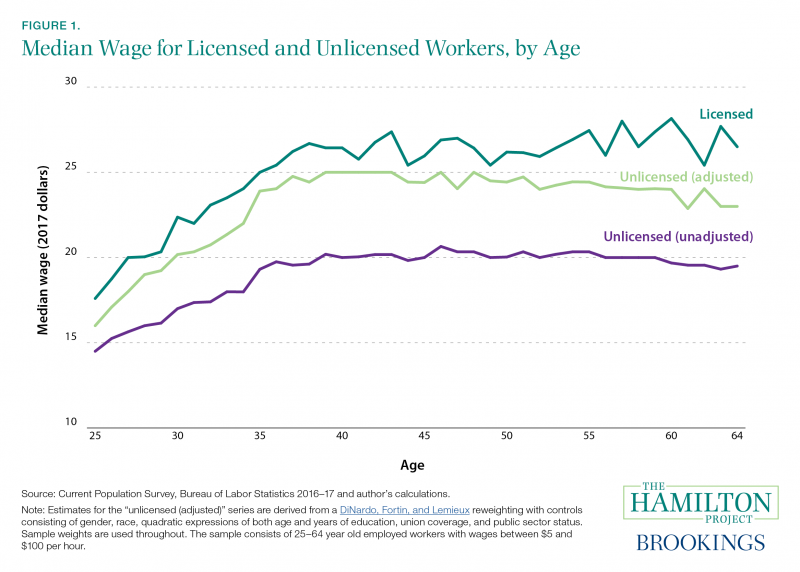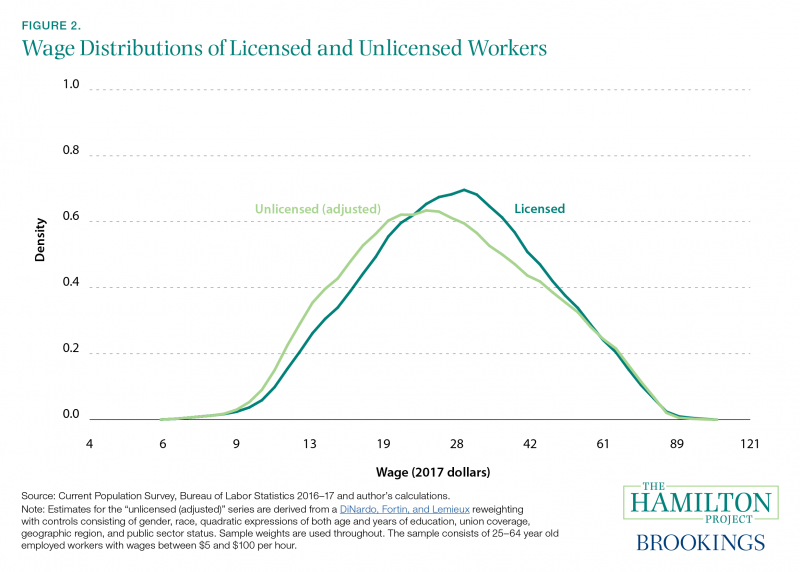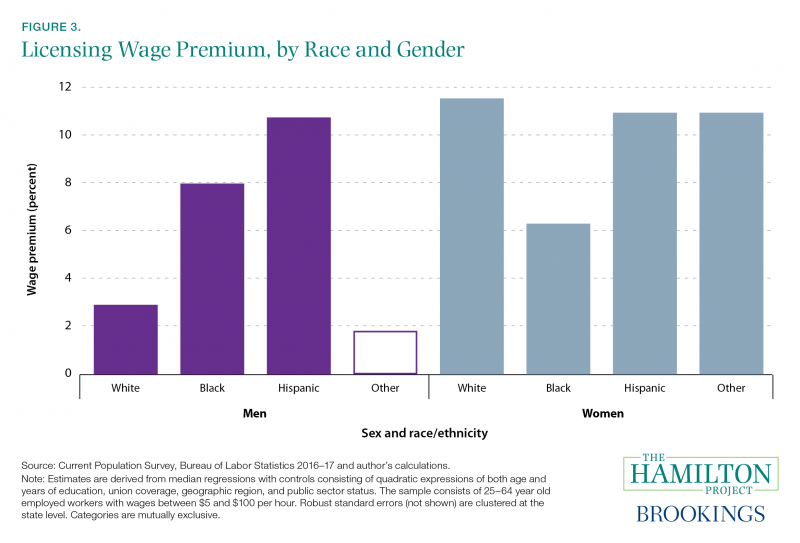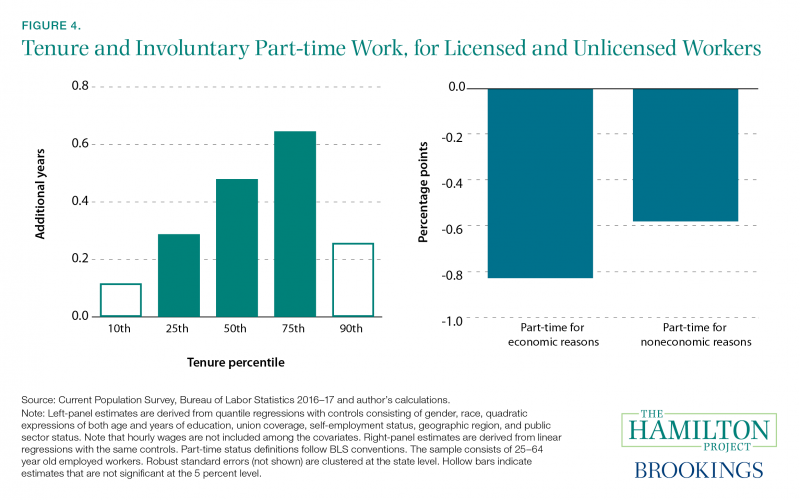Occupational licensing—the legal requirement that a credential be obtained in order to practice a profession—is a common labor market regulation that ostensibly exists to protect public health and safety. However, by limiting access to many occupations, licensing imposes substantial costs: consumers pay higher prices, economic opportunity is reduced for unlicensed workers, and even those who successfully obtain licenses must pay upfront costs and face limited geographic mobility. In addition, licensing often prescribes and constrains the ways in which work is structured, limiting innovation and economic growth.
Researchers have studied these licensing impacts, and much of their analysis is well-summarized in a 2015 report released by the Obama administration. One important finding is that licensed workers tend to earn more than similar workers who are not required to obtain licenses: they receive a wage premium relative to unlicensed workers.
Using new data collected as part of the Current Population Survey, I focus on the ways that licensing affects the more than 20 percent of workers who have a license, as well as their counterparts who do not. This economic analysis extends previous research by examining how licensing relates to wages, tenure, and part-time status by age, race, gender, and wage level. For example, the wage advantage enjoyed by licensed workers relative to comparable unlicensed workers increases with age, rising from about $1.60 per hour at age 25 to $3.50 per hour at age 64.
Licensed workers also enjoy labor market advantages that go beyond higher wages. Licensed workers have longer job tenure and lower voluntary and involuntary part-time status. Median tenure is half a year longer for licensed workers, and involuntary part-time work is 0.8 percentage points less likely for licensed workers, after making adjustments for differences between them and their unlicensed counterparts (in terms of variables like age and educational attainment, among others). In addition, as documented in a previous Hamilton Project analysis, licensed workers also enjoy lower unemployment rates. These advantages at least partially reflect the exclusive rights that licensed workers are granted for certain types of work, with corresponding disadvantages imposed on unlicensed workers.
As with any important labor market institution, it is important to examine the association of licensing with wage inequality. Unlike collective bargaining, occupational licensing does not appear to mitigate income inequality. Wage inequality is about 6 percent higher in the licensed sector than in the unlicensed sector, after adjusting for observable ways in which workers differ.1
Like previous Hamilton Project analysis and proposals on this topic, this work is aimed at informing the evolving policy discussion about occupational licensing, which has been a policy priority of successive presidential administrations. A better understanding of the costs and benefits of occupational licensing contributes to a better targeted, more effective, and less burdensome regulatory regime; in turn, this boosts economic growth and enhances workers’ economic opportunities.
Licensing throughout the career
In order to obtain a license, workers must first pay the specified fees, undergo required training and education, and satisfy any other state licensing requirements. Depending on the state and occupation, the upfront costs of licensure vary from minimal ($70 and 3 days of training for a school bus driver in Michigan) to very substantial ($1,485 and 6 years of additional education for an interior designer in the District of Columbia).
These upfront costs—including the opportunity cost of lost wages while undergoing training—partially offset any later benefits derived by newly licensed workers in the form of higher wages. Workers already practicing in a profession when it becomes licensed are an exception, as they are often exempted from new licensing requirements. Consequently, the labor market effects of licensing can be delayed, increasing in magnitude as time passes and more workers are required to meet new requirements.
Using nearly two years of new Current Population Survey (CPS) data on worker licenses, previous findings are broadly confirmed: 21 percent of employees aged 25–64 hold a license required for their current job, while 3 percent report a certificate.2 Workers with licenses earn considerably more than those without: $18.80 per hour for the median unlicensed worker versus $25.00 for the median licensed worker.3
While much of this advantage for licensed workers is accounted for by differences in age, human capital, and other variables that typically confer increased wages, some of the licensing wage premium is thought to be caused by the barrier to entry that a license represents. In other words, the difficulty of obtaining a license—in excess of the entry requirements that a market would impose with full information about provider quality—restricts labor supply in the occupation, thereby improving conditions for licensed workers and harming them for the unlicensed. Unlicensed workers see their potential occupational choices diminished, and must crowd into occupations with lower barriers to entry. This transfer to licensed workers is called an “economic rent”, and it generally involves a costly labor market distortion.
Identifying the licensing wage difference that can be deemed an economic rent is a difficult challenge. One common approach is to adjust for observable differences between workers (sometimes including broad occupational categories) and infer that the remaining wage difference—the wage premium—is due to the barrier to entry. Though useful, it is important to note that this approach may under- or over-estimate the rents generated by licensing, particularly if licensed and unlicensed workers are different in unobservable ways or if the need for licensing impels a worker to obtain high-value training, for example.
Estimates of the wage premium that remains after adjustment for observable differences vary depending on the econometric methods and data employed, but in recent CPS data, the estimated hourly wage premium is about 5 to 8 percent.4 One way to visualize the wage differences between unlicensed and licensed workers is shown in figure 1. The figure contains the median wages of licensed and unlicensed employed workers, shown by age. For unlicensed workers, wages are shown with and without adjustment for observable differences between the groups. Median wages of these groups are quite different throughout workers’ careers. Even after adjustment is made for differences in worker characteristics, licensed individuals are still paid more than the unlicensed at every age, and this gap increases throughout workers’ careers.

Licensing across the wage distribution
Estimates of licensing wage premiums are usually expressed in terms of the average worker. However, there is reason to believe that licensing affects wages differently in various parts of the wage distribution. For example, the outlay of time and money required to obtain a cosmetology license in New Mexico—notably including at least 1,600 hours of cosmetology instruction from an approved school—may be a serious impediment for those with limited means and significant family responsibilities, while presenting less of an obstacle for others. Consequently, licensing could be a larger effective barrier to entry for some low-skilled workers, thereby generating larger wage premiums.
Recognizing the possibility that licensing has different effects for different workers, an alternative approach is to calculate the distribution of wages for unlicensed workers, but reweighted to achieve comparability with licensed workers (figure 2). This adjusted distribution can then be contrasted with the wage distribution of licensed workers. Intuitively, this procedure puts additional weight on those unlicensed workers who are comparable with licensed workers in terms of observable variables like education, age, race, and gender, and uses their labor market experiences to formulate a more apples-to-apples comparison. As shown in figure 2, the wage distributions are most different at lower and middle wages, where unlicensed workers are more likely to be found.5

Licensing and inequality
Having examined how the levels of wages differ between licensed and unlicensed workers, it is also useful to investigate potential differences in the dispersion of wages. In other words, how does wage inequality differ between these groups, after adjusting for observable differences between licensed and unlicensed workers? It is important to note that answering this question does not necessarily reveal the impact that adding a licensing restriction would have on inequality, but it is informative about how inequality within their ranks compares with inequality for unlicensed workers.
I take the approach originally used by David Card to study union wage-setting and subsequently employed to study licensed workers by Kleiner and Krueger and Gittleman and Kleiner. These researchers were generally unable to find statistically significant differences in wage dispersion between the licensed and unlicensed, but they exploited smaller and older datasets than the Current Population Survey data used in this analysis.
When implementing this approach for the entire sample of employed 25–64 year old workers, inequality in the wages of licensed workers is statistically significantly higher—about 6 percent more—than that of unlicensed workers, adjusting for observable differences in worker characteristics.6
This inequality may reflect so-called scope of practice restrictions that benefit one licensed profession at the expense of another. For example, when especially stringent licensing rules limit the ability of nurse practitioners to work autonomously, they receive lower wages and physicians receive higher wages, thereby boosting wage inequality.
By contrast, as noted by Card, Kleiner, Krueger, and other researchers, union coverage is clearly associated with lower inequality. Using the same approach just applied to licensing, inequality in the union sector is about 6 percent below that of the nonunion sector. Though unions are not the focus of this paper, it is noteworthy that unions and licensing appear to affect the distribution of wages in different ways.
Licensing premiums by race and gender
Covering more than 20 percent of workers, licensing is so pervasive—and its requirements so variable across states and occupations—that it would be surprising if its effects were the same for workers of various ages, wage levels, and demographic groups. Indeed, wage premiums vary across all those dimensions, including race and gender.
After adjusting for observable differences between workers, two broad findings stand out: men tend to receive smaller licensing premiums than women, while black and Hispanic men receive relatively high wage premiums. Figure 3 shows the median wage premiums for black, Hispanic, and white men and women, with men and women of other race/ethnic groups combined into an additional category. Accordingly, gender and race wage gaps are smaller within the licensed sector than for the population as a whole. However, it is important to note that, if licensing barriers to entry disproportionately exclude low-skilled workers, that would help explain this pattern.

Using a different dataset—the Survey of Income and Program Participation—Blair and Chung conduct a more detailed investigation and find broadly similar results. They show that relatively large licensing wage premiums for black men are partly accounted for by the common limitation of licensure to workers with no felony convictions on their records. Because employers tend to pay lower wages to workers with felony convictions, a licensing requirement that bans those with criminal records can produce a larger wage premium by separating those with convictions from those without them.
How to interpret wage premiums
Workers earn widely varying wages that depend on their skill level, local labor market institutions and economic conditions, labor market discrimination, and a host of other factors. Moreover, there is certainly some error in workers’ reports of licensed status, particularly insofar as it is accurately distinguished from having a certificate (i.e., a credential that is not legally required to practice). Wage premium estimates should therefore be understood as suggestive of—but not entirely conclusive about—the “rents” accruing to a license. In particular, unobserved worker characteristics or circumstances may be associated with both licensed status and wages, biasing estimates of the wage premium in either direction. To the extent that a license functions as a signal of high skill level, it can yield wage differences that are not rents generated by a barrier to entry.
It is also important to understand the economic implications of an accurately measured wage premium. If a licensed worker earns 8 percent more than an unlicensed worker—after adjusting for all wage-relevant considerations—this does not mean that licensing has simply boosted wages of licensed workers 8 percent above a baseline level that all workers would receive in the absence of licensing. In fact, economists expect that the imposition of licensing both raises wages of licensed workers and lowers wages of unlicensed workers, some of whom have been prevented from entering their preferred occupation and must crowd into a less-preferred profession.
Beyond the wage premium
Wages are certainly an important part—usually the most important part—of overall compensation and the quality of a job. However, other aspects of a job are also important, and it may be that licensed and unlicensed jobs vary systematically in terms of the non-wage value of a job. Because some components of non-wage job quality can be difficult to measure directly (e.g., work environment), indirect measures are sometimes used to evaluate job quality. One such measure is job tenure: the duration of a match between a particular firm and worker.
Tenure is substantially elevated for licensed workers. The left panel of figure 4 shows the “tenure premium” of licensed workers at different percentiles of the tenure distribution. Licensing is associated with higher tenure particularly at the middle of the distribution.

Another means of evaluating job quality for licensed and unlicensed individuals is to examine how likely they are to be working part-time, whether for economic reasons (i.e., working part-time because of inability to find full-time employment) or for so-called noneconomic reasons (i.e., because of child-care responsibilities or family obligations).7 Part-time work for economic reasons is often referred to as “involuntary” underemployment, and is therefore generally undesirable. Again, the jobs worked by licensed workers tend to be higher quality: after controlling for individual characteristics like educational attainment and age, licensed employed workers remain 0.8 percentage points less likely to work part-time for economic reasons than their unlicensed counterparts.
The right panel of figure 4 shows the association between licensing and part-time for economic reasons or part-time for noneconomic reasons status, respectively, after adjustments are made for differences in worker characteristics. Licensed workers are also less likely to be working part-time for noneconomic reasons, though the difference is somewhat smaller than that observed for involuntary part-time work. Lower rates of voluntary part-time work may be due to the upfront costs of licensing, which are only acceptable to workers who plan to work full-time and thereby recoup their initial expenditures.
Conclusion
Perhaps the most important question one can ask about an occupational licensing requirement is whether it is the most appropriate means of promoting public safety in any particular instance. This assessment must reflect a clear view of both the benefits and the costs of licensure, many of which are experienced by workers. By choosing the most appropriate form of occupational regulation, policymakers can achieve important social goals while minimizing the burden placed on workers, consumers, and the overall economy.
This report contributes to an accurate assessment of licensing by exploring in more detail the ways that this labor market institution affects workers with different earnings levels and from different demographic groups. By examining non-wage labor market outcomes, it provides a more comprehensive analysis of how workers are affected by licensing. Indeed, superior outcomes for licensed workers (and corresponding inferior outcomes for unlicensed workers) are pervasive and robust to adjustments for observable differences between those groups. Licensing generates economically important labor market distortions that must be carefully considered when regulating the labor market.
Acknowledgements
I am grateful to Lauren Bauer, Peter Blair, Martha Gimbel, Morris Kleiner, Gabriel Scheffler, and Jay Shambaugh for insightful comments, and to Patrick Liu, Becca Portman, and Rachel Williams for excellent research assistance.
Endnotes
- Following Kleiner and Krueger and Gittleman and Kleiner, wage inequality is defined here in terms of residual hourly wage dispersion.
- The data used in this paper—collected from January 2016 through December 2017—include a variable that better distinguishes credentials that are legally required for one’s current employment (licenses) from credentials that are not legally required (certificates). Consequently, the estimate of the licensed fraction given here is slightly lower than that reported by BLS when they do not impose this restriction. Notably, a state-issued credential that functions as a license in one occupation or state may function as a certificate in another occupation or state.
- Unless stated otherwise, all calculations in this report are for 25–64 year old employed workers. For wage estimates, values below $5 and above $100 per hour are removed; this eliminates 1 percent of the sample. Imputed values are included in the analysis.
- This is somewhat smaller than other estimates in the literature, reflecting a relatively extensive set of adjustments and a focus on hourly wages. The estimate controls for gender, race, quadratic expressions of both age and years of education, union coverage, geographic region, and public sector status; education is the most important of these variables. When detailed occupations are additionally included in the controls, the estimates are closer to the bottom end of the range.
- Results are similar when detailed occupational controls are implemented. A recent paper by Kleiner and Vorotnikov—using different data and econometric methods—conducts a qualitatively similar exercise, finding that licensing is associated with larger wage differences at the top of the wage distribution than at the bottom and middle.
- Inequality is defined as the conditional mean squared error of log wages. I control for gender, race, quadratic expressions of both age and years of education, union coverage, geographic region, public sector status, and detailed occupation. The sample consists of 25–64 year old employed workers with wages between $5 and $100 per hour.
- I am grateful to Charlie Brown for the suggestion to investigate this question.




